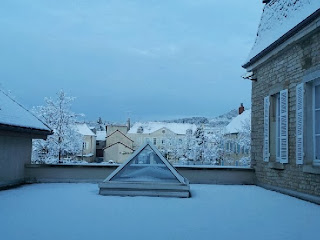From this tasting, it is clear that Israeli winemakers have worked very hard to demonstrate to the world that Israeli wines are much more than a topic of interest - they have an identity and a promising future! Key importers are still the US, France, UK, Germany.....it will be nice to see some of these wines reaching the shores of Hong Kong very soon!
There are 5 main regions: Galilee, including Lower Galilee, Upper Galilee and the Golan Heights (the latter two known for high altitude vineyards with cooler climates); Shomron, the Sharon Plain near the Mediterranean coast and just south of Haifa, which is the largest grape-growing region in the country (includes Mount Carmel, Sharon and Shomron Hills); Samson, including Judean Plains and Judean Foothills; and the Judean Hills, south of Jerusalem and the semi-arid Negev region.
The first wine we tasted was a 2012 Gewurztraminer by Lueria Winery. The vines are planted in a high altitude (875 metres) vineyard, facing North/NW, in the foothills of Mount Meron in the Upper Galilee. Pale straw yellow in colour. The nose showed notes of rose, pineapple, kiwi, Turkish Delight and some spice. Nicely aromatic, does not have the weight or richness typical of this grape variety, well balanced by fresh acidity. A very respectable introduction to Israeli wines!
We then tasted 6 red wines:
2010 Four Seasons Pinotage, Assaf
85% Pinotage, with 15% Shiraz, Cabernet Sauvignon and Cabernet Franc. Deep ruby in colour. Pronounced intensity of coffee, dark chocolate, blackberry and dark cherry, dried fruit, with notes of herbal and sweet tobacco. Medium bodied, with high tannin and acidity. A little bitterness at the finish.
2009 Carignan, SoMek
Made with 40-year-old Carignan vines from the Carmel Region. Aged in French oak barrels for 24 months before bottling and ageing for another 2 years before release. Medium ruby colour. Black cherry, pepper, liquorice, vanilla and toast. Medium-full body, high acidity, with ripe tannin, with a firm backbone. The alcohol was a bit higher at 14% abv, but well disguised by the layers of high quality ripe fruit. Can easily be enjoyed now or for further cellaring.
2011 Layam, Agur
Agur is a boutique winery with vineyards in the Judean Hills, south of Jerusalem. This wine showed cool climate characteristics and a fine balance and elegance, in a mid-weight style. 50% Syrah and 50% Mourvedre, grown in the Judean Hills. Aged for 14 months in 1-year French oak barrels. Red fruit, black pepper, herbal and violet. Purity of fruit persisted on the palate, enhanced with a stoney mineral note, finishes almost salty! (Layam means "To the Sea".) A wine to be enjoyed now and in the mid-term.
2010 Lennon, Sea Horse Winery
Sea Horse Winery is a boutique winery located in the Judean Hills, where there are big diurnal differences between warm days and very cool nights, especially at the higher altitudes. Sea Horse is about 500 metres high, with the vineyards on terra rosa soils. This wine was dedicated to John Lennon......Organically grown Zinfandel, at 500 metres high, with very low yields. 75% Zinfandel, 12.5% Petite Syrah and 12.5% Mourvedre. Aged in American oak for 16 months. Succulent and fleshy, notes of dark cherry, dried fruit and spice. Ripe firm tannin, balanced by a medium level of acidity. A very good effort for Zinfandel....and rather moreish.
2011 Shoresh, Tzora Vineyards
A blend of 80% Cabernet Sauvignon, 17% Syrah and 3% Merlot. Vineyard in the Judean Hills. 16 months in French barriques. I very much liked the finesse and elegance, balance and complexity of this wine. Dark fruit, black pepper, graphite and some herbaceous notes. Full-bodied but well balanced with lively acidity and ripe firm tannin. Well-made and well-proportioned. Finishes long. I particularly liked the sensible alcohol level of 13.5% abv! 2011 had a cooler growing season (2010 was a very hot year).....and this helped deliver a fine harmony to this wine. A wine that can be enjoyed now, just, with many years of life ahead.
2010 Black Tulip, Tulip
Flagship wine of the Tulip Winery. This is a blend of 62% Cabernet Sauvignon, 22% Merlot, 10% Cabernet Franc and 6% Petit Verdot, mostly from Judean Hills vineyards, with some Cabernet Sauvignon from the Upper Galilee. This is an opulent example of a Bordeaux blend from Israel, from a very ripe vintage, showing notes of ripe blackberry preserve, dried fruit, tobacco, vanilla and toast. Velvety textured, with a full body and firm structure to give long ageing potential. This came in at a whopping 15.5% abv! A wine for mid to long-term cellaring. I would try this again in 6 - 8+ years' time. (Tulip Winery is also known for the role it plays in the community, offering people with special needs employment at the winery.)
That was my first tasting of Israeli wines....educational and interesting.....so far so impressive.....and I look forward to trying more - a visit to Israel would be even better!




































.jpg)







